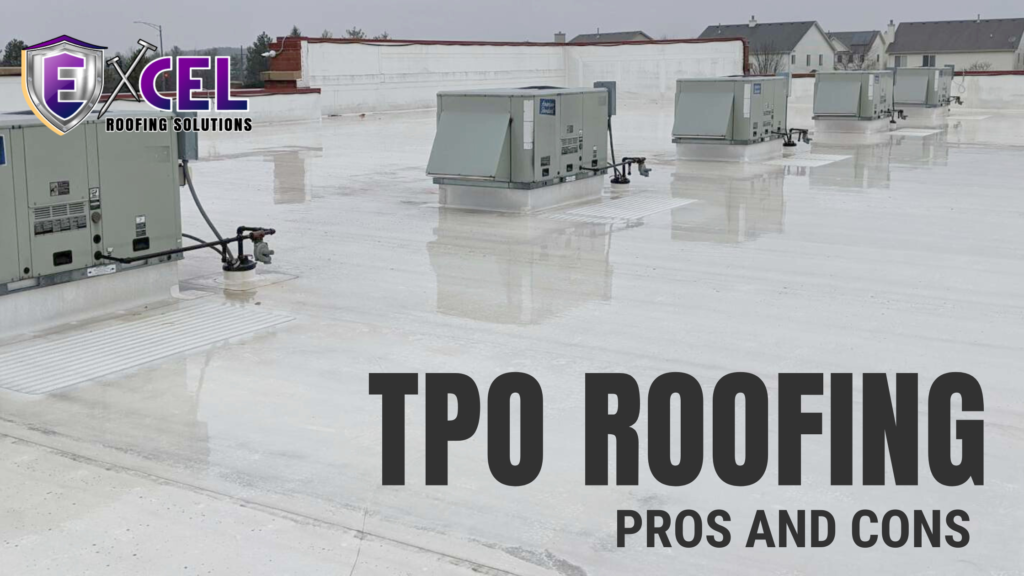When it comes to roofing materials, there’s a wide array of options available, each with its own set of advantages and disadvantages. Thermoplastic Olefin (TPO) roofing has gained popularity in recent years for its versatility, durability, and energy efficiency. However, like any roofing material, TPO comes with its own set of pros and cons that homeowners and building owners should consider before making a decision. In this blog post, we’ll explore the pros and cons of TPO roofing to help you make an informed choice for your roofing needs.
Remember, your roof is an investment in the safety and longevity of your property. Choose TPO roofing with confidence and let Excel Roofing Solutions bring your vision to life.
Contact Excel Roofing Solutions today! – (336) 221-4121
Pros of TPO Roofing:
- Affordability: One of the primary advantages of TPO roofing is its affordability compared to other roofing materials like PVC or EPDM. TPO is typically less expensive to install, making it an attractive option for budget-conscious homeowners and building owners.
- Energy Efficiency: TPO roofing is known for its energy-efficient properties, which can help reduce cooling costs during hot summer months. TPO roofs have high solar reflectivity and thermal emittance, meaning they reflect sunlight and heat away from the building, keeping interior spaces cooler and reducing the need for air conditioning.
- Durability: TPO roofing is highly durable and resistant to damage from UV rays, chemicals, punctures, and tears. This makes it an ideal choice for areas with extreme weather conditions, such as hail or high winds. Additionally, TPO roofs are resistant to mold, algae, and bacterial growth, helping to prolong their lifespan.
- Easy Installation: TPO roofing is lightweight and flexible, making it relatively easy and quick to install compared to other roofing materials. Its large sheets can be heat-welded together to create a seamless, watertight membrane, reducing the risk of leaks and water damage.
- Environmentally Friendly: TPO roofing is considered environmentally friendly because it can be recycled at the end of its lifespan. Many TPO manufacturers offer recycling programs, allowing old TPO membranes to be repurposed into new roofing materials, reducing waste and environmental impact.
Cons of TPO Roofing:
- Long-Term Performance: While TPO roofing is durable and resistant to many types of damage, its long-term performance can vary depending on factors such as installation quality, climate conditions, and maintenance. Some homeowners and building owners have reported issues with TPO roofs, such as seam failures, membrane shrinkage, and premature cracking.
- Limited Color Options: Unlike other roofing materials like asphalt shingles or metal roofing, TPO roofing has limited color options available. While white is the most common color choice for TPO membranes due to its high solar reflectivity, homeowners looking for more aesthetic options may find the lack of color variety limiting.
- Susceptibility to Ponding Water: TPO roofing membranes can be susceptible to ponding water if the roof’s slope is not properly designed or if drainage systems become clogged or ineffective. Ponding water can lead to premature deterioration of the membrane and potential leaks if not addressed promptly.
- Quality Variability: Not all TPO roofing membranes are created equal, and the quality can vary significantly between manufacturers and products. It’s essential to choose a reputable manufacturer and installer with a proven track record of quality and reliability to ensure the longevity and performance of your TPO roof.
- Maintenance Requirements: While TPO roofing is relatively low-maintenance compared to other roofing materials, it still requires regular inspections and maintenance to ensure optimal performance and longevity. Routine inspections should be conducted to check for signs of damage, such as punctures, tears, or seam failures, and any issues should be addressed promptly to prevent water infiltration and damage to the underlying structure.
TPO roofing offers many benefits, including affordability, energy efficiency, durability, and environmental sustainability. However, it’s essential to weigh these advantages against the potential drawbacks, such as long-term performance issues, limited color options, susceptibility to ponding water, variability in quality, and maintenance requirements. By carefully considering the pros and cons of TPO roofing and working with a reputable manufacturer and installer, homeowners and building owners can make an informed decision that meets their roofing needs and budget.
Ready to explore TPO roofing for your property? Contact Excel Roofing Solutions today for expert advice, quality installations, and reliable service! – (336) 221-4121


